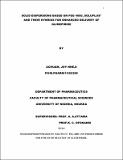UNNSpace Repository
Solid Dispersions Based on Peg 4000, Soluplus® and their Hybrids for Enhanced Delivery of Glimepiride
JavaScript is disabled for your browser. Some features of this site may not work without it.
| dc.contributor.author | Achuam, Joy Nneji
|
|
| dc.date.accessioned | 2017-03-13T13:26:02Z | |
| dc.date.available | 2017-03-13T13:26:02Z | |
| dc.date.issued | 2017-03-13 | |
| dc.identifier.uri | http://hdl.handle.net/123456789/3873 | |
| dc.description.abstract | The present study investigates the possibility of enhancing the solubility, and hence the bioavailability of poorly water soluble glimepiride via formation of polyethylene glycol-polyvinyl caprolactam - polyvinyl acetate grafted copolymer (Soluplus®) and PEG 4000 based solid dispersions by solvent evaporation technique.Different batches of glimepiride solid dispersions (SD) were prepared using solvent evaporation method with Soluplus® and PEG 4000 as polymer matrix at different ratios. The percentage yield, morphology, drug content, micromeritic properties and drug dissolution studies (in different media: SIF pH 7.4 and SGF 1.2) of the dispersions were evaluated. These formulations were characterized for solid state properties using differential scanning calorimetry (DSC) and fourier transform infrared (FTIR) studies. The formulations were further evaluated for alloxan-induced antidiabetic and stability studies.The different batches formulated showed excellent morphology, good flow properties, practical yield and drug content. Solid state characterisation indicated that glimepiride was present in its amorphous form in formulations with Soluplus® and PEG 4000 due to efficient entrapment in the polymer matrix and with no drug-polymer interaction. The dissolution rate of all the solid dispersions was found to be significantly (P < 0.05) more rapid when compared to pure drug in both media except for P2 solid dispersion when compared with the commercial sample in SIF pH 7.4. In the first 30 min, percentage (%)drug released from SDs were 65.83 %, 57.93 %, 58.47 %, 51.45 %, 80.83 %, 81.67 %, 84.02 %, 70.97 %,71.13 % and 46.80 % for batches S1, S2, P1, P2, SP1, SP2, SP3, SP4, SP5 and Amaryl®, respectivelyin SIF, pH 7.4. At the end of 120 min, batch SP3 solid dispersion showed maximum % drug released of 96.11 and 57.08 in SIF pH 7.4 and SGF pH 1.2 respectively, while batch P2 had least % drug released of 74.55 and 40.45 in SIF pH 7.4 and SGF pH 7.4 respectively. The kinetics of drug release from all the solid dispersions followed first order. Glimepiride in its pure form had very slow dissolution rate, when compared with the solid dispersions. The blood glucose reduction in albino rats by the solid dispersions was significantly (p < 0.05) more and sustained when compared with the pure drug sample. The maximum percentage (%) blood glucose reduction of 9.81 % and 8.97 % was achieved in 3 hours for the two groups (A and C, respectively) treated with SDs batch SP1 and SP3. Thus, the solid dispersions prepared with Soluplus® and polyethylene glycol 4000 might be useful for delivering poorly soluble glimepiride with enhanced solubility and dissolution rate. | en_US |
| dc.language.iso | en | en_US |
| dc.subject | Solubility and dissolution rate | en_US |
| dc.subject | Formation of polyethylene glycol-polyvinyl | en_US |
| dc.subject | Poorly water soluble glimepiride | en_US |
| dc.title | Solid Dispersions Based on Peg 4000, Soluplus® and their Hybrids for Enhanced Delivery of Glimepiride | en_US |
| dc.type | Thesis | en_US |
